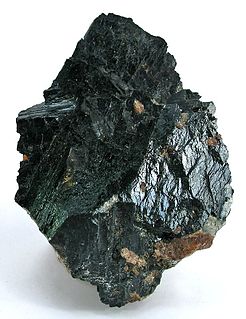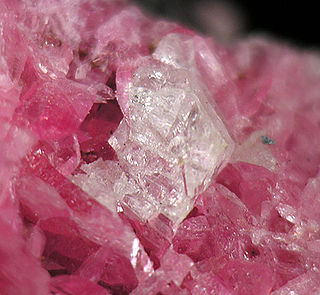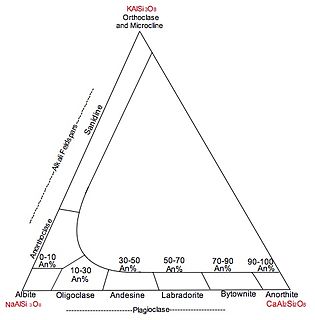 W
WIn geology and mineralogy, a mineral or mineral species is, broadly speaking, a solid chemical compound with a fairly well-defined chemical composition and a specific crystal structure, that occurs naturally in pure form..
 W
WMineralogy is an active science in which minerals are discovered or recognised on a regular basis. Use of old mineral names is also discontinued, for example when a name is no longer considered valid. Therefore, a list of recognised mineral species is never complete.
 W
WA gemstone is a piece of mineral crystal which, in cut and polished form, is used to make jewelry or other adornments. However, certain rocks and occasionally organic materials that are not minerals are also used for jewelry and are therefore often considered to be gemstones as well. Most gemstones are hard, but some soft minerals are used in jewelry because of their luster or other physical properties that have aesthetic value. Rarity is another characteristic that lends value to a gemstone.
 W
WAlabaster is a mineral or rock that is soft, often used for carving, and is processed for plaster powder. Archaeologists and the stone processing industry use the word differently from geologists. The former use it in a wider sense that includes varieties of two different minerals: the fine-grained massive type of gypsum and the fine-grained banded type of calcite. Geologists define alabaster only as the gypsum type. Chemically, gypsum is a hydrous sulfate of calcium, while calcite is a carbonate of calcium.
 W
WAxinite- (Mg) is a borosilicate of aluminum, calcium and magnesium of the axinite group, with magnesium as the dominant cation in the place of the structure that can also be occupied by iron and manganese. It was discovered in gem material from Merelani Hills, Lelatema Mts, Manyara region (Tanzania), which is consequently its type locality. It was initially called magnesioaxinite, referring to its membership in the axinite group and the role of magnesium as the dominant cation. The International Mineralogical Association (IMA) later changed its name to axinite- (Mg). Occasionally it has been carved as a collection gem.
 W
WBritholite-(Ce) is a rare radioactive mineral with the chemical formula (Ce,Ca)5(SiO4)3OH. It comes in a variety of different colors. Its type locality is Naujakasik (Naajakasik), Tunulliarfik Fjord, Ilímaussaq complex, Narsaq, Kujalleq, Greenland.
 W
WCacholong, also known as Kalmuck agate, is a form of common opal, although it is often mistaken for agate or chalcedony. A milky white colour with a Mohs hardness of about 6, it is used for carving, cameos, etc. Found in Austria, Czech Republic, Mongolia and Uzbekistan, its name possibly comes from a river in Uzbekistan.
 W
WCahnite (Cahnit in German, Cahnita in Spanish, Канит in Russian) is a brittle white or colorless mineral that has perfect cleavage and is usually transparent. It usually forms tetragonal-shaped crystals and it has a hardness of 3 mohs. Cahnite was discovered in the year 1921. It was named Cahnite to honor Lazard Cahn (1865–1940), who was a mineral collector and dealer. It is usually found in the Franklin Mine, in Franklin, New Jersey. Until the year 2002, when a sample of cahnite was found in Japan, that was the only known place that cahnite was located. The geological environment that it occurs in is in pegmatites cutting a changed zinc orebody. The chemical formula for cahnite is Ca2B[AsO4](OH)4. It is made up of 26.91% calcium, 3.63% boron, 25.15% arsenic, 1.35% hydrogen, and 42.96% oxygen. It has a molecular weight of 297.91 grams. Cahnite is not radioactive. Cahnite is associated with these other minerals: willemite, rhodonite, pyrochroite, hedyphane, datolite, and baryte.
 W
WChalconatronite is a carbonate mineral and rare secondary copper mineral that contains copper, sodium, carbon, oxygen, and hydrogen, its chemical formula is Na2Cu(CO3)2•3(H2O). Chalconatronite is partially soluble in water, and only decomposes, although chalconatronite is soluble while cold, in dilute acids. The name comes from the mineral's compounds, copper ("chalcos" in Greek) and natron, naturally forming sodium carbonate. The mineral is thought to be formed by water carrying alkali carbonates (possibly from soil) reacting with bronze. Similar minerals include malachite, azurite, and other copper carbonates. Chalconatronite has also been found and recorded in Australia, Germany, and Colorado.
 W
WA concretion is a hard, compact mass of matter formed by the precipitation of mineral cement within the spaces between particles, and is found in sedimentary rock or soil. Concretions are often ovoid or spherical in shape, although irregular shapes also occur. The word 'concretion' is derived from the Latin con meaning 'together' and crescere meaning 'to grow'. Concretions form within layers of sedimentary strata that have already been deposited. They usually form early in the burial history of the sediment, before the rest of the sediment is hardened into rock. This concretionary cement often makes the concretion harder and more resistant to weathering than the host stratum.
 W
WConflict resources are natural resources extracted in a conflict zone and sold to perpetuate the fighting. There is both statistical and anecdotal evidence that belligerent accessibility to precious commodities can prolong conflicts. The most prominent contemporary example has been the eastern provinces of the Democratic Republic of the Congo (DRC), where various armies, rebel groups, and outside actors have profited from mining while contributing to violence and exploitation during wars in the region.
 W
WCoupled substitution is the geological process by which two elements simultaneous substitute into a crystal in order to maintain overall electrical neutrality and keep the charge constant. In forming a solid solution series, ionic size is more important than ionic charge, as this can be compensated for elsewhere in the structure.
 W
WFreudenbergite is a mineral that is named in honor of Wilhelm Freudenberg, palaeontologist at the University of Tübingen and the University of Göttingen, and curator for mineralogy and geology at the National Collections of Natural History in Karlsruhe. He studied Katzenbuckel rocks.
 W
WFuller's earth is any clay material that has the capability to decolorize oil or other liquids without the use of harsh chemical treatment. Fuller's earth typically consists of palygorskite (attapulgite) or bentonite.
 W
WHexagonite is the red to pink, lilac to purple manganoan variety of tremolite. A rare amphibole, it can be transparent, translucent, and rarely opaque.
 W
WIce is water frozen into a solid state. Depending on the presence of impurities such as particles of soil or bubbles of air, it can appear transparent or a more or less opaque bluish-white color.
 W
WIddingsite is a microcrystalline rock that is derived from alteration of olivine. It is usually studied as a mineral, and consists of a mixture of remnant olivine, clay minerals, iron oxides and ferrihydrites. Debates over iddingsite's non-definite crystal structure caused it to be de-listed as an official mineral by the IMA; thus it is properly referred to as a rock.
 W
WKovdorskite, Mg2PO4(OH)·3H2O, is a rare, hydrated, magnesium phosphate mineral. It was first described by Kapustin et al., and is found only in the Kovdor Massif near Kovdor, Kola Peninsula, Russia. It is associated with collinsite, magnesite, dolomite, hydrotalcite, apatite, magnetite, and forsterite.
 W
WLautite is a rare mineral belonging to the class of sulfides and sulfosalts with the general formula CuAsS. It is orthorhombic and is known to form up to 2.3 cm long prismatic or flat crystals. It is also found as grains or masses.
 W
WLayered double hydroxides (LDH) are a class of ionic solids characterized by a layered structure with the generic layer sequence [AcB Z AcB]n, where c represents layers of metal cations, A and B are layers of hydroxide anions, and Z are layers of other anions and neutral molecules. Lateral offsets between the layers may result in longer repeating periods.
 W
WMaskelynite is a glassy material found in some meteorites and meteorite impact craters. Typical samples are similar in composition to plagioclase feldspar, and revert to that mineral when melted and recrystallized. It was named after British geologist M.H.N. Story-Maskelyne.
 W
WMineral evolution is a recent hypothesis that provides historical context to mineralogy. It postulates that mineralogy on planets and moons becomes increasingly complex as a result of changes in the physical, chemical and biological environment. In the Solar System, the number of mineral species has grown from about a dozen to over 5400 as a result of three processes: separation and concentration of elements; greater ranges of temperature and pressure coupled with the action of volatiles; and new chemical pathways provided by living organisms.
 W
WA mineral lick is a place where animals can go to lick essential mineral nutrients from a deposit of salts and other minerals. Mineral licks can be naturally occurring or artificial. Natural licks are common, and they provide essential elements such as phosphorus and the biometals required in the springtime for bone, muscle and other growth in deer and other wildlife, such as moose, elephants, tapirs, cattle, woodchucks, domestic sheep, fox squirrels, mountain goats and porcupines. Such licks are especially important in ecosystems with poor general availability of nutrients. Harsh weather exposes salty mineral deposits that draw animals from miles away for a taste of needed nutrients. It is thought that certain fauna can detect calcium in salt licks.
 W
WMyrmekite describes a vermicular, or wormy, intergrowth of quartz in plagioclase. The intergrowths are microscopic in scale, typically with maximum dimensions less than 1 millimeter. The plagioclase is sodium-rich, usually albite or oligoclase. These quartz-plagioclase intergrowths are associated with and commonly in contact with potassium feldspar. Myrmekite is formed under metasomatic conditions, usually in conjunction with tectonic deformations. It has to be clearly separated from micrographic and granophyric intergrowths, which are magmatic.
 W
WIn sedimentology and geology, a nodule is a small, irregularly rounded knot, mass, or lump of a mineral or mineral aggregate that typically has a contrasting composition, such as a pyrite nodule in coal, a chert nodule in limestone, or a phosphorite nodule in marine shale, from the enclosing sediment or sedimentary rock. Normally, a nodule has a warty or knobby surface and exists as a discrete mass within the host strata. In general, they lack any internal structure except for the preserved remnants of original bedding or fossils. Nodules are closely related to concretions and sometimes these terms are used interchangeably. Minerals that typically form nodules include calcite, chert, apatite (phosphorite), anhydrite, and pyrite.
 W
WNovaculite, also called Arkansas Stone, is a microcrystalline to cryptocrystalline rock type that consists of silica in the form of chert or flint. It is commonly white to grey or black in color, with a specific gravity that ranges from 2.2 to 2.5. It is used in the production of sharpening stones. It occurs in parts of Arkansas, Oklahoma, and Texas, as well as in Japan and parts of the Middle East. The name novaculite is derived from the Latin word novacula, meaning a sharp knife, dagger, or razor in reference to its use in sharpening.
 W
WA primary mineral is any mineral formed during the original crystallization of the host igneous primary rock and includes the essential mineral(s) used to classify the rock along with any accessory minerals. In ore deposit geology, hypogene processes occur deep below the earth's surface, and tend to form deposits of primary minerals, as opposed to supergene processes that occur at or near the surface, and tend to form secondary minerals.
 W
WA raw material, also known as a feedstock, unprocessed material, or primary commodity, is a basic material that is used to produce goods, finished products, energy, or intermediate materials that are feedstock for future finished products. As feedstock, the term connotes these materials are bottleneck assets and are required to produce other products. The term raw material denotes materials in unprocessed or minimally processed states; e.g., raw latex, crude oil, cotton, coal, raw biomass, iron ore, air, logs, water, or "any product of agriculture, forestry, fishing or mineral in its natural form or which has undergone the transformation required to prepare it for international marketing in substantial volumes".
 W
WRed mud, also known as bauxite residue, is an industrial waste generated during the refinement of bauxite into alumina using the Bayer process. It is composed of various oxide compounds, including the iron oxides which give its red color. Over 95% of the alumina produced globally is through the Bayer process; for every tonne of alumina produced, approximately 1 to 1.5 tonnes of red mud are also produced. Annual production of alumina in 2018 was approximately 126 million tonnes resulting in the generation of over 160 million tonnes of red mud.
 W
WRock butter is a soft mineral substance found oozing from alum slates.
 W
WRutilated quartz is a variety of quartz which contains acicular (needle-like) inclusions of rutile. It is used for gemstones. These inclusions mostly look golden, but they also can look silver, copper red or deep black. They can be distributed randomly or in bundles, which sometimes are arranged star-like, and they can be sparse or dense enough to make the quartz body nearly opaque. While otherwise inclusions often reduce the value of a crystal, rutilated quartz in fact is valued for the quality and beauty of these inclusions.
 W
WSinhalite is a borate mineral with formula MgAl(BO4).
 W
WSylvinite is a sedimentary rock made of a mechanical mixture of the minerals sylvite and halite. Sylvinite is the most important source for the production of potash in North America, Russia and the UK. Most Canadian operations mine sylvinite with proportions of about 31% KCl and 66% NaCl with the balance being insoluble clays, anhydrite and in some locations carnallite. Other deposits of sylvinite are in Belarus, Brazil, France, Germany, Kazakhstan, Slovakia and Spain.
 W
WTenebrescence, also known as reversible photochromism, is the ability of minerals to change colour when exposed to light. The effect can be repeated indefinitely, but is destroyed by heating.
 W
WA thunderegg is a nodule-like rock, similar to a filled geode, that is formed within rhyolitic volcanic ash layers. Thundereggs are rough spheres, most about the size of a baseball—though they can range from a little more than a centimeter to over a meter across. They usually contain centres of chalcedony which may have been fractured followed by deposition of agate, jasper or opal, either uniquely or in combination. Also frequently encountered are quartz and gypsum crystals, as well as various other mineral growths and inclusions. Thundereggs usually look like ordinary rocks on the outside, but slicing them in half and polishing them may reveal intricate patterns and colours. A characteristic feature of thundereggs is that the individual beds they come from can vary in appearance, though they can maintain a certain specific identity within them.
 W
WTitanomagnetite is a mineral containing oxides of titanium and iron, with the formula Fe2+(Fe3+,Ti)2O4. It is also known as titaniferous magnetite. It is part of the spinel group of minerals. The Curie temperature for titanomagnetite has been found to have a wide range of 200 to 580°C.
 W
WTumchaite, Na2(Zr,Sn)Si4O11•H2O, is a colorless to white monoclinic phyllosilicate mineral. It is associated with calcite, dolomite, and pyrite in the late dolomite-calcite carbonatites. It can be transparent to translucent; has a vitreous luster; and has perfect cleavage on {100}. Its hardness is 4.5, between fluorite and apatite. Tumchaite is isotypic with penkvilksite. The structure of the mineral is identified by silicate sheets parallel {100}, formed by alternation of clockwise and counterclockwise growing spiral chains of corner-sharing SiO4 tetrahedra. Tumchaite is named for the river Tumcha near Vuoriyarvi massif.